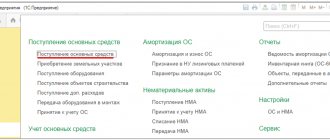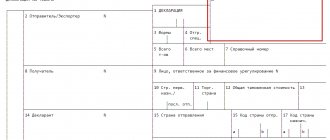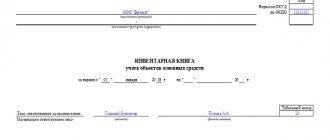Why is numbering needed?
Accountants who have been working at enterprises for more than one year know that their organization has fixed assets on its balance sheet, but not everyone in practice is faced with the need to accept a new fixed asset item. Some accounting workers have no idea how to correctly carry out this procedure, register an object in the accounting registers and reflect it on the balance sheet. There are many reasons why an inventory number of fixed assets is necessary:
- The presence of a large number of objects at the enterprise;
- Constant movements of material assets;
- Existence of leased buildings, machinery, machinery and equipment;
- Regular inventories of the organization's funds.
Knowing how inventory numbers are assigned to fixed assets, an enterprise accountant will constantly have up-to-date information about the state of fixed assets accounting and promptly provide it to the organization’s management and regulatory authorities.
The official document that you need to refer to when resolving this issue is the Methodological Guidelines for Accounting for Fixed Assets, approved by Order of the Ministry of Finance of the Russian Federation on October 13, 2003 No. 91 n. Here we will only briefly outline the necessary steps and the approximate sequence of the procedure.
Basic Rules
- Each OS object is assigned an inventory number once for the entire period of its operation.
- If an object consists of several parts, each is numbered separately.
- The number of an object written off the balance sheet should not be assigned to other types of property of the enterprise for 5 years.
- Moving the OS within the enterprise does not serve as a reason to change the number.
- Leased funds can be accounted for by numbers assigned by the lessor.
Numbering of fixed assets
The Order on the accounting policy of an enterprise must include a clause on how to assign inventory numbers to fixed assets. The numbering order of the OS is reflected here, that is, the inventory number, how many digits it can have, is regulated only by this document. In enterprises where the number of objects is small, you can use simple numbering: 001, 002, 003, etc. For a large number of objects, a more complex system is used, let’s take No. 0104001, where:
01 - code in synthetic accounting (Chart of Accounts);
04 — code of a structural unit of the organization (warehouse, workshop, office);
001 - serial number of OS in the list of items similar in purpose.
Inventory number example:
A forklift has arrived at warehouse No. 2, and the same warehouse already has one. The inventory number of a new forklift can be set using the above method:
- 01 - account number in the Chart of Accounts;
- 02 - warehouse number;
- 002 is the serial number of forklifts in this warehouse.
In this case, the number will be 0102002.
Method of applying the number to the OS
In the practice of accountants, there are cases when it is impossible to apply numbering to an object using accessible methods; in such situations, data about the operating system is stored only on accounting registers. Objects to be numbered can be marked using any method possible for the organization:
- Using paint and stencil:
- Apply stickers or tokens;
- Use engraved plates.
Advice. Do not forget that by applying the inventory number incorrectly, you can spoil the numbering object itself; carefully consider all the nuances before you begin to act.
The head and chief accountant of the organization must constantly monitor the correct and timely registration of the movement of fixed assets, this will ensure their safety, allow for prompt receipt of clear information, and will help in organizing the entire work of the enterprise.
Federal standard “Fixed assets” - accounting from 2021 in 1C: BSU
When filling out the tabular part and creating an item in the Fixed Assets directory, pay attention to the new field “NFA Type”. In setting up the accounting reflection, we indicate the method of calculating depreciation “100% upon commissioning.” In the postings we see that depreciation is written off 100%.
How to assign inventory numbers to budgetary institutions
Clause 9 of the Standard approved by Order of the Ministry of Finance of Russia dated December 31, 2016 No. 257n “Each inventory item of fixed assets is assigned an inventory number in the manner established by the accounting policy of the accounting entity, taking into account the provisions of this Standard and the Instructions for the application of the Unified Chart of Accounts for public authorities (state bodies), local governments, management bodies of state extra-budgetary funds, state academies of sciences, state
1.3. The Inventory Commission ensures the completeness and accuracy of entering into the inventory records data on the actual balances of property and the reality of the accounted liabilities, the correctness and timeliness of registration of inventory materials.
Room requirements
By and large, there are only two requirements for an inventory number: the number must be unique, and the numbering system must be orderly.
Uniqueness refers to the assignment of only one unique inventory number to one object. Simply put, the same number cannot be assigned to two or more objects and, conversely, one object should not be assigned two or more inventory numbers. Moreover, we recommend adhering to this rule even if the object has been removed from the balance sheet. To avoid possible confusion, it is better not to assign the number of a retired object to a new one. After all, documentation for the retired object continues to be stored in the organization, and mixing numbers can lead to errors.
As for orderliness, here we are talking about arranging them in a certain system, and not about creating numbers randomly. This allows the accountant, without looking at the object card, to find out its main characteristics from the first numbers, which significantly speeds up the process of inventory and accounting. Agree, when it is immediately clear from the number what type of object it is, when it was purchased and where it is located, this is convenient.
What is an inventory number
Fixed assets can be used in work only after they have been accepted for accounting. The unit of such accounting is an inventory object. To monitor the safety of items, their use and condition, they are assigned numbers.
To organize accounting and ensure control over the safety of fixed assets, each inventory item of fixed assets must be assigned a corresponding inventory number when accepting them for accounting.
Order of the Ministry of Finance of the Russian Federation dated October 13, 2003 N 91n (as amended on December 24, 2010) “On approval of the Methodological Guidelines for Accounting of Fixed Assets”, paragraph 1, paragraphs. eleven
Features of number assignment:
- The number is indicated on each object.
- You cannot change the code while it is in use.
- A number can be assigned to an object whose parts have an equal useful life.
Parts of a single object cannot be assigned different codes. It is also not possible to combine several objects under one number. This type of numbering is used only in the company’s internal accounting. When transferring ownership, the number is not retained.
Depreciation of fixed assets
Government institutions charge depreciation of fixed assets linearly over their service life. There is also a rule of monthly accruals in the amount of 1/12 of the annual amount. Depreciation charges begin to be reflected in the month following the month the facility is put into operation.
Read about the practical application of the linear method in the article “Linear method of calculating depreciation of fixed assets (example, formula).”
For the following types of fixed assets, depreciation is reflected at 100% when taken into account:
- real estate not more expensive than 40,000 rubles;
- library objects no more than 40,000 rubles;
- other objects of movable property from 3,000 to 40,000 rubles.
For objects of movable property no more than 3,000 rubles. (except for library objects) depreciation is not charged.
Depreciation is reflected in the synthetic account 010400000 “Depreciation”.
To record entries for depreciation charges, analytical accounts ending in 410 are used, which are used in the following transaction: Dt 040120271 “Depreciation costs of fixed assets and intangible assets”, 010900000 “Costs of manufacturing finished products, performing work, services” (010960271, 010970271 , 010980271, 010990271) Kt 010400000 “Depreciation” (010411410–010413410, 010415410, 010418410, 010431410–010438410).
To account for fixed assets leased: Dt 040120271 “Depreciation costs of fixed assets and intangible assets” Kt 010440000 “Depreciation of leased items” (010441410–010448410).
In paragraphs 19, 20 instructions to the chart of accounts (order No. 162n) consider special cases of reflecting depreciation, for example, for fixed assets received free of charge.
Inventory number and features of its use
An inventory number is assigned to a property at the time it is accepted for registration. After this, it acquires the status of an inventory object - a control unit. The number is applied to the object using durable paint, a barcode, engraving, using a token that cannot be quickly and discreetly removed, or in another similar way. The number must be applied so that during an inventory it can be easily and without errors identified with the BU data.
The main objects in relation to which management is organized in this way and control is exercised are:
- OS - fixed assets, objects of property of the organization that have been in operation for more than a year, are intended for production needs, and the cost of which is a legally defined amount;
- intangible objects, assets (IMA) - these include products of intellectual labor, for example, technological developments, software development, trademarks, brand names and other objects that do not have a material form, but which can in the future bring material benefits (see. Civil Code of the Russian Federation Article 1225-1, PBU 14/07);
- non-produced objects, assets - these are natural objects, subsoil, lands, water bodies, etc.
Objects costing less than 3 thousand rubles. no inventory number needed.
The following mandatory requirements apply to inventory numbers:
- they should not be duplicated;
- they must be assigned in order.
In addition, when using inventory numbers in accounting records, it is important to be guided by the following important information:
- The inventory number is applied in the presence of a commission specially created for this purpose and recorded in the inventory number journal.
- If the inventory object is a whole consisting of separate functional parts, a number is applied to each part.
- Moving an inventory item within the organization or its divisions is not a reason to change the number or adjust it. The inventory number does not change during the entire operation of the object to which it is assigned.
- If fixed assets are leased by a company, they are usually accounted for by numbers assigned by the lessor. At the same time, from Resolution 11 of the Arbitration Court of Appeal No. A55-24142/2013 dated 04/28/14, it follows that when the rights to an inventory object are transferred, for example, when signing a leasing agreement, it may be assigned a new inventory number of the organization that acquired such rights. It is argued that the assignment of inv. numbers are an internal matter of the organization.
- The inventory number of an object deregistered (sold, written off, etc.) cannot be assigned to another object in the same organization.
What objects are subject to numbering
Codes are assigned to the following objects:
- Fixed assets. These are tangible items that can be used in work for 12 months or more. For example, equipment, tools, furniture, etc.
- Intangible objects. For example, a movie, a multimedia product, technology.
- Non-produced assets. These are the resources of the earth's interior, land plots, etc.
The codes are indicated in the documentation for accounting for fixed assets and are used during inventory. Movable and immovable property is taken into account.
Library collection objects are assigned codes regardless of cost. All objects are subject to numbering, regardless of whether they are used in work or are in stock.
How to keep records of low-value fixed assets
Not a day without instructions × Not a day without instructions
- Services:
Low-value fixed assets 2021 are the property of an organization, the value of which does not exceed the limit established by law, and it can be taken into account as part of expenses at a time, and not through depreciation charges. Let’s figure out which fixed assets are considered low-value and how to properly account for them in a budget organization, taking into account the changes in 2021.
January 11, 2021 Author: Natalya Evdokimova To determine which objects can be classified as low-value fixed assets, from what amount for 2021 to count and how to count, we will determine the maximum limits. Cost limits have been adjusted. Now, fixed assets subject to immediate write-off on the balance sheet should include objects that cost 10,000 rubles or less.
Let us recall that until 2021, fixed assets with a value of up to 3,000.00 rubles were recognized as such property.
General drafting rules
The legislation does not provide for a special procedure for assigning numbers. The organization has the right to independently develop these regulations. The procedure is prescribed in the accounting policy of the enterprise or another act.
The main requirement is to indicate a unique number for each object. It is unacceptable for designations to be repeated. If a fixed asset is deregistered, its number can be assigned to another object after at least 5 years.
The numbers must be sequential. In large organizations, it is better to develop guidelines for assigning codes. The number may consist of several parts: a company branch, a division, a code within a division. When transferring funds to other branches, they will not be lost. Small firms can use simple numbering starting from 1.
Method of applying the number to the OS
In the practice of accountants, there are cases when it is impossible to apply numbering to an object using accessible methods; in such situations, data about the operating system is stored only on accounting registers. Objects to be numbered can be marked using any method possible for the organization:
- Using paint and stencil:
- Apply stickers or tokens;
- Use engraved plates.
Advice. Do not forget that by applying the inventory number incorrectly, you can spoil the numbering object itself; carefully consider all the nuances before you begin to act.
The head and chief accountant of the organization must constantly monitor the correct and timely registration of the movement of fixed assets, this will ensure their safety, allow for prompt receipt of clear information, and will help in organizing the entire work of the enterprise.
Documenting
Well, in conclusion, let’s say a few words about documenting all the above rules. As we have already said, “accounting numerology” is not regulated in any way by law. This means that the organization can implement the listed rules independently by approving the corresponding local act.
There are several ways to do this. For example, add a corresponding section to the organization’s accounting policy, or make an appendix to it. However, we do not recommend using this option, because... The accounting policy is subject to special rules regarding the introduction of changes and adjustments (clauses 6 and 7 of Article 8 of the Accounting Law). Therefore, it is not worth introducing additional provisions into it, so as not to deprive yourself of freedom of maneuver.
It is better, in our opinion, to use another option - to include rules for numbering objects in the Regulations on conducting an inventory in an organization. In such a document, the numbering rules will look quite logical. And it would be useful to familiarize yourself with them not only for the accountant, but also for any employee included in the inventory commission.
Finally, you can approve a separate document in the organization - Regulations on the procedure for assigning inventory numbers.
How to create an inventory number: example
A computer was used for accounting. The object was issued to unit number 9. The last registered code is 0121.
The computer belongs to the list of “Machinery and Equipment”. As a result, the object was registered under number 9101340122:
- 9 - department code.
- 101 - synthetic accounting code.
- 34 - analytical account code.
- 122 — object number in order.
During the reorganization of an enterprise from one form of ownership to another, its owner changes. Each new owner sets new inventory numbers for all objects.
The cadastral registration authorities store information about buildings: the inventory number of the house and an additional code in the form of numbers or letters. This number allows you to determine the area and type of property.
There are no strict instructions on how to correct errors when assigning numbers. Depending on the situation, you can complete the item, write it off, or register a new item.
Inventory of objects must be carried out by attentive and responsible accountants according to regulations. Errors in accounting for funds are punished by regulatory authorities. The company will pay fines if the accounting procedure is violated.
How to build a numbering system
What information exactly can and should be “encoded” in the inventory number? For example, it can reflect an accounting account; depreciation group number; OKOF code; period of registration (year, month); division (branch) or building (building) in which the facility will be used. That is, in essence, the inventory number can be similar to the VIN of a car, which also encrypts all the information, from the place and year of manufacture to the configuration. And again, by analogy with the automobile industry, the inventory number can consist not only of numbers, but also of letters. For example, letters can be used to encode the period of acceptance for accounting, or the location of the object.
When choosing the information that needs to be encoded in the number, you must remember that an overly complex and (or) redundant structure of the inventory number is inconvenient to work with. Accordingly, the number should include only those criteria that will actually be used in the work. And, of course, when compiling a number, you need to take into account the capabilities of the software used in the company: whether they can support all the criteria “coded” in the number.
Acceptance of fixed assets for accounting in 2021
results in the payment of property tax, for which rates and benefits are clarified in 2021.
Some fixed assets, after being accepted for accounting, are not subject to tax. Do you have any of these? Read the article. Guest, get free access to the BukhSoft program Full access for a month! — Generate documents, test reports, use the unique expert support service of the Glavbukh System in the working window of the BukhSoft program.
Request a call back or call us by phone (free).
Attention! Familiarize yourself with the basic rules for calculating and paying monthly and quarterly advances on income tax from leading specialists of the Federal Tax Service. Download reference books and sample documents that will help you pay income taxes correctly and on time: Methodological instructions from the Federal Tax Service.
Download for free the Federal Tax Service Guidelines.
Download for free the Federal Tax Service Guidelines.
Assigning inventory numbers to fixed assets
General approaches to assigning inventory numbers to fixed assets are specified in the Guidelines for accounting of fixed assets (Order of the Ministry of Finance of the Russian Federation No. 91n dated 10/13/2003 (as amended on 12/24/2010)) and Instruction No. 157n (Order of the Ministry of Finance of the Russian Federation dated 12/01/2010). According to them:
- the inventory number is unique, that is, there should not be two fixed assets with the same inventory numbers,
- if the object is composite, that is, it consists of elements that make up a single whole, then all parts of the complex fixed asset are allocated one single inventory number,
- inventory numbers must be in order,
- the inventory number does not change when the location of a fixed asset object changes within the same organization,
- once an inventory number is attached to a fixed asset, it remains with it throughout the entire time it is in the organization,
- inventory numbers of fixed assets removed from balance sheet accounting are not assigned to newly accepted fixed assets for accounting,
- For a fixed asset received by an organization under a lease agreement, the same inventory number may be used that was assigned to the fixed asset by the lessor.
We put the number correctly
Typically, inventory numbers are applied directly to the object. However, there are nuances here too. First of all, it is worth specifying where exactly the number is applied. This will greatly simplify the inventory process itself, since the commission will know exactly where to look for the number and will not have to examine the object from all sides in search of the “cherished” numbers. In addition, this approach will improve the aesthetic appearance of the objects - they will look neat even after many years.
For example, you can establish a rule in your organization that the inventory number on machinery and equipment is always applied next to the factory number (easy to find; this place is protected from harmful influences). And on cabinets and bedside tables that have doors - inside, on the upper inner corner of the left door (easy to apply; less likely to be damaged during use and cleaning; visible during any rearrangement). By the same logic, on tables it is better to place the number on the inside of the leg or on the side panel.
Finally, some objects are too small to be numbered. In such cases, the number may not be applied at all, which must be noted on the inventory card. In this case, it is advisable to configure the accounting program in such a way that the accountant can quickly generate a list of such unmarked objects indicating their physical location. This will speed up the inventory process.
Fixed assets in budget accounting - 2018-2019: introductory information and changes
In accordance with paragraph 21 of Order No. 157n, the concept of “budget accounting of fixed assets” applies only to certain government organizations. For example, government institutions, government agencies, extra-budgetary funds. In addition to the unified chart of accounts, a special chart of accounts must be used in budget accounting (Order of the Ministry of Finance of Russia dated December 6, 2010 No. 162n).
The remaining government institutions, maintaining accounting and tax accounting of fixed assets in 2018-2019, in addition to the unified chart of accounts, use charts of accounts approved by order of the Ministry of Finance of Russia dated December 16, 2010 No. 174n or dated December 23, 2010 No. 183n (depending on the type of organization) and others regulations.
Read about the regulatory documents governing accounting in budgetary structures.
In this article we will refer to orders No. 157n and 162n as the basis for budget accounting. However, this material may also be useful to other budget structures, since it reveals the general principles of OS accounting from 2021, and especially the logic of making transactions.
One of the main criteria for recognition of fixed assets is the service life of the property, namely an interval exceeding 12 months. In addition, the facility must be used to carry out the activities of the institution permanently or repeatedly. Another feature is that the operating systems are not owned by the institution, but are quickly managed.
NOTE! Fixed assets do not include objects classified as inventories in accordance with clause 99 of Order No. 157n. For example, fishing gear, gas-powered saws, etc.
The service life can be determined according to the OS classifier approved by Decree of the Government of the Russian Federation dated January 1, 2002 No. 1, according to the maximum limit for groups 1–9. And for OS with a service life of more than 30 years, the standards from the Decree of the Council of Ministers of the USSR No. 1072 dated October 22, 1990 are applied. The SPI may be revised during modernization.
Each inventory item as a unit of accounting for fixed assets must be assigned a number. And an inventory card is created for each object, with the exception of items costing less than 3,000 rubles and library objects.
To account for fixed assets, a synthetic account 010100000 “Fixed Assets” is provided. The budget accounting account number consists of 26 digits, and only 18–26 digits are used in the accounting of the institution. Depending on the group and type of fixed assets, as well as the essence of their movement, the code in the 22–26 digits changes in the account number.
Below we consider the scheme for generating an accounting account number in a budgetary organization, and also decipher the category codes using an example. A detailed explanation of the categories can also be found in clause 21 of the instructions to the chart of accounts (order No. 157n), in the table of the budget accounting chart of accounts and in clause 2 of the instructions to it (order No. 162n).
| Account digit number | ||||
| Financial support | Accounting object | Accounting object group | Type of accounting object | Type of receipts, disposals of an accounting object |
| Example: account 110118310 “Increase in the value of other fixed assets - real estate of the institution” | ||||
| 1 - at the expense of the budget | 101—fixed assets | 1—real estate | 8 - other fixed assets | 310 - increase in OS cost |
Read about creating a working chart of accounts in a budget organization.
Note that for budget accounting of fixed assets, according to Order No. 162n, only 2 types of financial support are possible: at the expense of the budget (code 1) and funds at temporary disposal (code 3).
Thus, government institutions, government agencies and other organizations falling under the jurisdiction of Order No. 162n cannot have their own non-budgetary income.
The main changes in accounting for fixed assets in 2016–2018 are associated with the introduction into force of the All-Russian Classifier OF (OKOF) OK 013-2014 (SNA 2008) on 01/01/2017.
The latest changes in fixed asset accounting are as follows:
- Since 2021, film and photographic equipment, due to a reduction in useful life, has been classified in group 3 of fixed assets accounting, and in 2016–2018 its useful life is 3–5 years.
- In 2021, objects with a new value limit (100,000 rubles) began to be accepted for tax accounting of fixed assets. This limit is valid for OSes put into operation after 2015.
- In 2021, the provisions reflected in the main documents on the rules for accounting for fixed assets have been clarified in relation to objects leased, free use, trust management, and also those that are the subject of concession agreements.
In addition, the texts of orders No. 157n and 162n, related to the accounting of fixed assets, have undergone a number of editorial changes.
Accounting for the tenant
An important point is that the leased asset, which is registered by the tenant, must strictly comply with specific requirements:
- the object is used exclusively in the main (production and economic) activities of the organization;
- the regulated useful life of this asset exceeds twelve months;
- there is a real possibility of profitable use of the fixed asset;
- the asset was acquired by the owner not for subsequent resale to third parties.
Thus, the compliance of a property object with all of the above criteria is the basis for its registration as an asset related to fixed assets.
The fact of transfer and acceptance of an asset under a lease agreement is necessarily certified by the execution of the corresponding act, which, as is known, is a necessary addition (appendix) to the agreement concluded between the lessor and the lessee.
Operating lease of fixed assets
Economic relations involving the transfer (provision) and acceptance (receipt) of a specific fixed asset item for a certain fee under temporary operation conditions are most often carried out under an operating lease.
A characteristic feature of this transaction is the immutability of the owner of the leased asset.
Operation of an asset provided under an operating lease is permitted solely for its intended purpose - only to perform production tasks.
The lessee, however, has the right to improve the technical and operational parameters of the leased equipment (asset), having previously agreed upon the relevant measures with the lessor (owner) of the fixed asset.
How to take into account the value on off-balance sheet account 001?
The fact of acceptance and registration of an asset by the tenant is recorded in the debit of account 001.
At what cost should the asset be accounted for? The fixed asset is accounted for by the lessee at the cost specified in the relevant lease agreement.
The disposal of an asset and its subsequent return to the lessor is reflected by the lessee on the credit of account 001.
By the way, account 001 refers to so-called off-balance sheet accounts in accounting.
Lease payments, which are periodically made by the tenant for the operation of the fixed asset, also require tax and, of course, accounting.
In essence, the rental fee for fixed assets is the direct costs of the tenant, reflected as part of the cost of the main or, alternatively, auxiliary production.
The specific scope of attribution of such costs is determined by the functional purpose of the leased equipment.
Postings
Payments for the lease of fixed assets are taken into account by the tenant enterprise as part of the expenses of its ordinary activities.
For tax accounting, rent is written off by the tenant as expenses that constitute the cost of services, work, and goods.
Taking into account the leased fixed assets, the lessee company draws up the following typical transactions:
| Operation (description) | Account debit | Account credit |
| The leased asset is registered | 001 | |
| The rent payment is included in the costs of the tenant company (excluding VAT) | 44,26,25,20 | 76 |
| The VAT amount is taken into account separately from the rental payment | 19 | 76 |
| The amount of VAT paid is deducted | 68 (according to VAT subaccount) | 19 |
| The rent payment is transferred to the lessor | 76 | 51 |
| The asset is returned to the lessor (upon expiration of the lease agreement) | 001 |
Depreciation
If an asset is used by an organization under an operating lease, the lessee enterprise does not charge depreciation on such an asset.
However, for tax accounting reasons, the lessee can depreciate capital investments (investments) in leased fixed assets on the following basis:
- the lessor of the fixed assets agreed in advance for the tenant to make such capital investments;
- the cost of such capital investments will not be reimbursed by the lessor to the lessee;
- such depreciation is carried out by the lessee during the term of the lease agreement;
- the amounts of such depreciation are calculated according to the regulated useful life of the leased fixed assets.
Write-off of fixed assets worth up to 100,000 rubles
→ → Current as of: March 4, 2021
Recognition of fixed assets as depreciable in accounting and tax accounting depends, among other things, on their cost.
We will tell you about the features of accounting for fixed assets up to 100,000 rubles in 2021 for accounting and profit tax purposes in our consultation. In accordance with clause 5 of PBU 6/01, a cost criterion is established in accounting, which allows assets that meet the criteria of fixed assets () to be taken into account not as fixed assets, but as inventories.
We recommend reading: Returning an electronic ticket on the RZL website
However, this cost limit is not 100,000 rubles, but 40,000 rubles. However, this criterion may be lowered.
In any case, it is important to consider that the objects of the main
Typical mistakes when assigning inventory numbers
Inaccuracies and errors made can not only bring chaos to the process of accounting for inventory items, but also lead to negative consequences when conducting external control. This is especially true for municipal unitary enterprises, other government organizations, and subordinate organizations. The most common ones are listed below:
- Discrepancies with the accepted accounting policy: arbitrary change in the length of the number, inclusion of letter designations in it, or, conversely, ignoring them in practice.
- Applying the number in a way that does not ensure its safety during the entire operation of the object: with weak dye, by gluing labels, etc.
- Failure to affix an inventory number due to the alleged impossibility of affixing it. Indeed, instruction 157n allows you not to physically affix this number, but only to enter it into the control unit registers under appropriate conditions. However, if the control commission discovers that the application was in fact possible, the organization may have problems.
- Applying an inventory number to objects arbitrarily, unnecessarily. Example: numbering an object worth less than 3,000 rubles.
Error 1. Incorrect number structure
There are no special requirements for the formation of inventory numbers either in Instruction No. 157n or in other regulatory legal acts. Therefore, institutions can independently develop a procedure for generating inventory numbers and reflect these rules in their accounting policies. Typically, the structure of the inventory number includes the information that an institution needs for operational accounting of non-financial asset objects, for example, a code for the type of activity where the object is used, a synthetic account code, an analytical account code, or a serial number. The first and quite common mistake is failure to comply with the requirements for the structure of inventory numbers recorded in the accounting policy - for example, if, according to the requirements of the accounting policy, the inventory number must consist of 10 characters, and the inventory number assigned to objects consists of 14 characters (see materials published on the official website of the Chuna district municipality: www.chuna.irkobl.ru, path: Chamber of Control / Results of control activities / Report No. 01-16/06 dated 11/14/2014).
Error 2. Incorrect choice of method for affixing the inventory number
The main methods for affixing inventory numbers assigned to fixed assets are listed in paragraph 46 of Instruction No. 157n. This regulatory document states that the inventory number assigned to an object must be designated by a financially responsible person in the presence of an authorized member of the commission for the receipt and disposal of assets by attaching a token to it, applying paint to the accounting object or in another way that ensures the safety of the marking. Thus, the list of methods for affixing inventory numbers is open, and practice shows that quite often specialists from institutions print out data on inventory numbers on paper and stick them with tape. This method is often used when assigning inventory numbers to stationary objects: benches in the gaming room, table tennis tables, etc. However, this approach often raises objections among inspectors. It is believed that in this case we can say that the inventory numbers are applied in a way that does not ensure their safety, that is, the requirements of paragraph 46 of Instruction No. 157n are violated - see, for example, the information posted on the official website of the Cherepovets municipal district (www. cherra.ru, act of control activities of the control and accounting committee of the Municipal Assembly of the Cherepovets Municipal District dated 10/05/2012 No. 33).
Error 3. Assigning inventory numbers when there is no such need
Instruction No. 157n provides for two situations when assigning separate inventory numbers to a piece of sports equipment is not necessary. Firstly, as we indicated above, this is the low cost of the object. Secondly, the classification of an object as a complex fixed asset or fixed asset with accessories is important. Sports equipment worth up to RUB 3,000. no inventory number is assigned. However, this is often forgotten. As an example, we can cite the materials of one of the audits conducted by the Control and Accounts Chamber of the city of Saratov. Specialists from the regulatory agency established that the institution’s balance sheet included items worth up to 3,000 rubles as fixed assets, including weights, expanders, and dumbbells. In violation of paragraph 46 of Instruction No. 157n, these objects were assigned unique inventory numbers - see the information published on the official website (www.kspsaratov.ru, path: About the chamber / Activities of the chamber / 2013 / Information on the results of an audit of the financial and economic activities of the institution health care "Center for Regenerative Medicine and Rehabilitation"). The basic rules for accounting for complex fixed assets or fixed assets with accessories are as follows (clauses 45 and 46 of Instruction No. 157n). An inventory object of fixed assets is an object with all fixtures and accessories, a separate structurally isolated object, a separate complex of structurally articulated objects. If one structurally articulated object has several parts - fixed assets that have different useful lives, each such part is accounted for as an independent inventory item. But if for a complex of structurally articulated objects consisting of several items, a common useful life for all objects is established, the specified object is taken into account as an independent inventory object. If a fixed asset object is complex (a complex of structurally articulated objects), that is, it includes separate elements (structural objects) that together form a single whole, each such element (structural object) must be marked with an inventory number assigned basic means (complex object, complex of structurally articulated objects). Despite the simplicity and logic of these regulatory rules, physical education and sports institutions may encounter problems when applying them to sports equipment. A typical example is basketball backboards. According to the appendix “Basketball Equipment” to the Rules of the sport “basketball” (approved by Order of the Ministry of Sports and Tourism of the Russian Federation dated May 12, 2010 No. 482), two shield designs are installed in the playing hall, each of which must consist of the following parts: – one shield; – one basket with a ring attached to the shield; – one grid; – one support supporting the shield; – upholstery. Practitioners may wonder how to assign accession numbers for these items. Practice shows that the desire to “play it safe” and record as many small fixed assets as possible in accounting is fraught with claims from inspectors. Thus, based on the materials of one of the inspections of the activities of institutions, the following was recorded as a violation by the control agency. In violation of paragraphs 41, 45, 47 of Instruction No. 157n, the institution assigned different inventory numbers to the devices listed in the accounting records (9 basketball hoops, 9 basketball nets, 9 basketball backboards), which actually represent 9 independent inventory objects - see materials , published on the official website of the Saratov municipal district www.saratov.sarmo.ru, path: Financial and legal sphere / Control and audit department / KRU activities 2015 / Act of the control and audit department of the Saratov municipal district of the Saratov region based on the results of an audit of the financial and economic activities of the Municipal educational institution “Secondary school in the village of Dubki, Saratov district, Saratov region”).
Error 4. Making a decision about the impossibility of affixing an inventory number
As expressly stated in paragraph 46 of Instruction No. 157n, if it is impossible to designate an inventory number on a fixed asset object in cases determined by the requirements of its operation, the inventory number assigned to it is used for accounting purposes with reflection in the relevant accounting registers without applying the fixed asset to the object . For many sports equipment, there is a temptation to apply this paragraph and not indicate the accession numbers. Is it possible to say that the requirements for using sports equipment for team games make it impossible to affix an equipment number? Materials from inspections of the activities of institutions do not always allow us to answer this question positively. In practice, the impossibility of designating an inventory number in cases determined by operational requirements is most often due to the fact that the affixed number is constantly erased and needs to be restored, or the object may deteriorate due to affixing the number. A classic example is dishes (pans, pots), the operating conditions of which require heating to high temperatures. In this case, when accepting the dishes for accounting as fixed assets, a special commission of the institution for the receipt and disposal of assets has the right to determine that, taking into account the special procedure, the inventory numbers on Such categories of fixed assets are not recorded, but are only reflected in the accounting registers. However, in our opinion, this approach should be used with caution in relation to sports equipment. Otherwise, there is a high probability of claims from specialists from regulatory agencies during inspections.
Sources
- https://mofree.ru/calculation/skolko-cifr-dolzhno-byt-v-inventarnom-nomere-chto-takoe.html
- https://ip-spravka.ru/inventarnyiy-nomer-osnovnyih-sredstv.html
- https://assistentus.ru/osnovnye-sredstva/kak-prisvoit-inventarnyj-nomer/
- https://buh-spravka.ru/buhgalterskij-uchet/os-nma-oborudovanie-k-montazhu/inventarnye-nomera-osnovnyh-sredstv.html
- https://praktibuh.ru/buhuchet/vneoborotnye/os/prochee/uchet-arendovannyh-os-u-arendatora.html
- https://www.audit-it.ru/articles/account/assets/a8/882401.html
Accounting for fixed assets upon admission to budgetary institutions
OS are received by institutions at actual cost, which includes:
- cost paid to the supplier;
- the cost of construction work when creating the facility;
- the cost of all costs required to create the OS;
- fare;
- amounts for related services;
- customs duties;
- as well as other costs associated with the purchase/creation of the OS.
NOTE! If the fixed asset will be used in budgetary activities, then the amount of input VAT is included in the initial cost.
The receipt of fixed assets is reflected in the synthetic account 0010600000 “Investments in non-financial assets”, which contains 3 grouping accounts:
- 0010611000 - for real estate;
- 0010631000 - for movable;
- 0010641000 - for accounting for financial lease objects.
In the accounting of fixed assets, to reflect receipts, separate analytical accounts are allocated, in 24–26 digits of which code 310 is used for each type of fixed assets (see the chart of accounts approved by Order No. 162n). This code indicates an increase in the cost of the OS.
The main entries for accounting for fixed assets upon receipt are shown in the table below. Other transactions can be found in paragraphs. 7, 31, 33, 34 instructions to the chart of accounts (order No. 162n).
| Wiring | Description of posting in fixed asset accounting |
| Dt 010600000 “Investments in non-financial assets” (010611310, 010631310, 010641310) Kt 020800000 “Settlements with accountable persons” (020831660, 020832660), 030200000 “Settlements for accepted obligations” (030231730, 030232730) | Purchasing an OS |
| Dt 010600000 “Investments in non-financial assets” (010611310, 010631310) Kt 030200000 “Settlements for accepted obligations”, 020800000 “Settlements with accountable persons”, 010400000 “Depreciation”, 030300000 “Settlements for payments to budgets”, 010500000 “Inventories” | Creating an OS object yourself |
| Dt 010100000 “Fixed assets” (010111310, 010112310, 010113310) Kt 010611310 “Increasing investments in fixed assets - real estate of the institution” | Commissioning of the constructed building |
| Dt 010100000 “Fixed assets” (010111310–010113310, 010115310, 010118310, 010131310–010138310) Kt 010611310 “Increase in investments in fixed assets - real estate of the institution”, 010631310 “Increase in investments in fixed assets - other movable property of the institution” | Commissioning of purchased, manufactured household goods. OS way |
| Dt 010100000 “Fixed assets” (010111310–010113310, 010115310, 010118310, 010131310–010138310) Kt 030404310 “Internal settlements for the acquisition of fixed assets” | The OS object was received from another budget institution that has the same budget resource manager |
| Dt 010100000 “Fixed assets” (010111310–010113310, 010115310, 010118310, 010131310–010138310) Kt 040110180 “Other income” | The OS object was received from another budgetary institution that has a different manager of budget resources at the same level, from organizations, individuals. |
| Dt 010100000 “Fixed assets” (010111310–010113310, 010115310, 010118310, 010131310–010138310) Kt 040110100 “Income of an economic entity” (040110151, 040110152, 040110153) | Other gratuitous receipts of fixed assets |
| Dt 010140000 “Fixed assets - leased items” (010141310–010148310) Kt 010641310 “Increasing investments in fixed assets - leased items” | Acceptance for registration in 2016–2018. OS leased |
For information on how the accounting policy of a budgetary institution is formed, read the material “An example of an accounting policy in a budgetary institution (nuances).”









